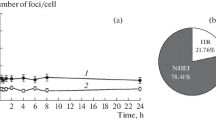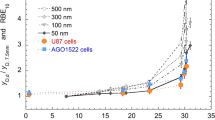Abstract
To postulate radiation action mechanisms and to test them by Monte Carlo simulation, a complex computer model was developed consisting of major components for the generation of a radiation spectrum, biomolecular structures, and electron track structures in liquid water. As the radiation source125I is employed here; it is an excellent test radiation due to its exactly localized position in the DNA molecule and high biological toxicity as a consequence of the emission of short-ranging Auger electrons. A linear DNA plasmid model (Pomplun 1991) which can actively respond to radical attack (Terrissol and Pomplun 1994) has been modified into a nucleosome model representing the double-helix of DNA with 146 basepairs and more than 9000 atoms surrounding the histones. The introduction of this new target structure allows a more realistic simulation of cellular conditions. Using the model's decay accumulation aspect, the situation of many break and survival experiments can be approximated and the influence of several cellular parameters tested. As a first step, a correlation between the size of energy depositions and strand-break patterns was sought.
Similar content being viewed by others
References
Beaudré A (1988) Simulation Spatio-Temporelle sur Ordinateur des Processus Radiolytiques Induits dans l'Eau par des Electrons. Thèse, I'Université Paul Sabatier, Toulouse, No. 371
Burki HJ, Roots R, Feinendegen LE, Bond VP (1973) Inactivation of mammalian cells after disintegrations of3H or125I in cell DNA at - 196° C. Int J Radiat Biol 24:363–375
Buxton GV, Grennstock CL, Helman WP, Ross AB (1988) Critical review of rate constants for reactions of hydrated electrons, hydrogen atoms and hydroxyl radicals in aqueous solutions. J Phys Chem Ref Data 17:513–586
Chandrasekaran R, Arnott S (1989) The structures of DNA and RNA helices in oriented fibers. (Landolt-Börnstein, New Series VII, 1b) Springer, Berlin Heidelberg New York
Charlton DE (1986) The range of high LET effects from125I decays. Radiat Res 107:163–171
Charlton DE, Humm JL (1988) A method of calculating initial DNA strand breakage following the decay of incorporated125I. Int J Radiat Biol 53:353–365
Feinendegen LE, Henneberg P, Tisljar-Lentulis G (1977) DNA strand breakage and repair in human kidney cells after exposure to incorporated iodine-125 and cobalt-60 γ-rays. Curr Topics Radiat Res Q 12:436–452
Hamm RN, Turner JE, Ritchie RH, Wright HA (1985) Calculation of heavy-ion tracks in liquid water. Radiat Res 104:S20-S26
Heller JM, Hamm RN, Birkhoff RD, Painter LR (1974) Collective oscillations in liquid water. J Chem Phys 60:3483–3486
Inagaki T, Hamm RN, Arakawa ET, Painter LR (1974) Optical and dielectric properties of DNA in the extreme ultra-violet. J Chem Phys 61:4246–4250
Kaplan IG, Sukhonosov VY (1991) Simulation of the passage of fast electrons and the early stage of water radiolysis by the Monte Carlo method. Radiat Res 127:1–10
Krisch RE, Krasin F, Sauri CJ (1977) DNA breakage, repair, and lethality accompanying125I decay in microorganisms. Curr Topics Radiat Res Q 12:355–368
Lappa AV, Bigildeev EA, Burmistrov DS, Vasilyev ON (1993) “Trion” code for radiation action calculations and its application in microdosimetry and radiobiology. Radiat Environ Biophys 32:1–19
LeMotte PK, Little JB (1984) DNA damage induced in human diploid cells by decay of incorporated radionuclides. Cancer Res 44:1337–1342
Martin RF, Haseltine WA (1981) Range of radiochemical damage to DNA with decay of iodine-125. Science 213:896–898
Painter RB, Young BR, Burki HJ (1974) Non-repairable strand breaks induced by125I incorporated into mammalian DNA. Proc Nail Acad Sci USA 71:4836–4838
Paretzke HG (1987) Radiation track structure theory. In: Freeman GR (ed) Kinetics of nonhomogeneous processes. Wiley, New York, pp 89–170
Paretzke HG (1988) Simulation von Elektronenspuren im Energiebereich 0.01–10 keV in Wasserdampf. (Report GSF 24/88) GSF Neuherberg, Munich
Pomplun E (1991) A new DNA target model for track structure calculations and its first application to I-125 Auger electrons. Int J Radiat Biol 59:625–642
Pomplun E, Booz J, Charlton DE (1987) A Monte Carlo simulation of Auger cascades. Radiat Res 111:533–552
Radford IR, Hodgson GS (1985)125I-induced DNA double strand breaks: use in calibration of the neutral filter elution technique and comparison with X-ray induced breaks. Int J Radiat Res 48:555–566
Sundell-Bergman S, Johanson KJ (1980) Repairable and unrepairable DNA strand breaks induced by decay of3H and125I incorporated into DNA of mammalian cells. Radiat Environ Biophys 18:239–248
Terrissol M (1978) Méthode de Simulation du Transport d'Électrons d'Énergies Comprises Entre 10 eV et 30 keV. Thèse, Université Paul Sabatier, Toulouse
Terrissol M, Beaudre A (1990) Simulation of space and time evolution of radiolytic species induced by electrons in water. Radiat Prot Dosim 31:175–177
Terrissol M, Pomplun E (1994) Computer simulation of DNA-incorporated125I Auger cascades and of the associated radiation chemistry in aqueous solution. Radiat Prot Dosim 52:177–181
Uehara S, Nikjoo H, Goodhead DT (1993) Cross-sections for water vapour for Monte Carlo electron track structure code from 10 eV to MeV region. Phys Med Biol 38:1841–1858
Yasui LS (1992) Cytotoxicity of125I decay in the DNA double strand break repair deficient mutant cell line, xrs-5. Int J Radiat Res 62:613–618
Zaider M, Vracko MG, Fung AYC, Fry JL (1994) Electron transport in condensed water. Radiat Prot Dosim 52:139–146
Author information
Authors and Affiliations
Rights and permissions
About this article
Cite this article
Pomplun, E., Terrissol, M. Low-energy electrons inside active DNA models: A tool to elucidate the radiation action mechanisms. Radiat Environ Biophys 33, 279–292 (1994). https://doi.org/10.1007/BF01210450
Received:
Accepted:
Issue Date:
DOI: https://doi.org/10.1007/BF01210450




